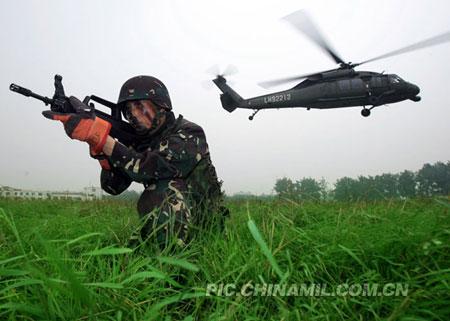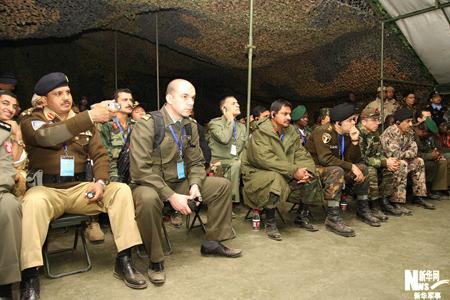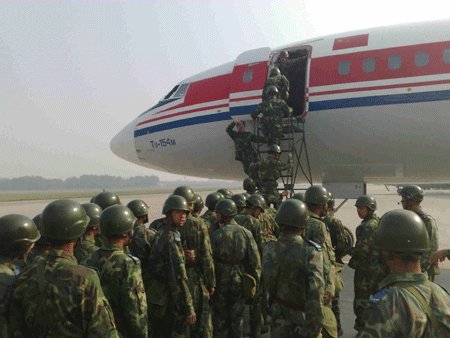First and foremost, the military training is developing towards the training under real-war conditions.
Military exercise is significant in that it is a way to test the effectiveness of the daily military trainings and represents an extended military training.

A foot soldier takes part in a joint training exercise on Tuesday. The exercise "Stride-2009" participated by one army division from each of the military commands of Shenyang, Lanzhou, Jinan and Guangzhou begins. The exercise will undergo a series of live-fire drills lasting for two months.
The first theatre-level joint campaign exercise , the first large-scale exercise found in the coverage of the year 2009, demonstrated the PLA s exploration for joint operation and command of various arms of services. This exercise laid down the essential requirements for the follow-up exercises of the year, i.e., the military exercises intended to serve the real war should seek for new ways of operation and training.
As far as the exercises serving the real war are concerned, the most notable one is undoubtedly the Stride 2009 trans-military area command (MAC) military exercise which received wide attention because of its long duration, high technology contents and strong resemblance to real war. In Stride 2009 , the troops from four MACs maneuvered respectively to one of the four MACs other than their own to conduct confrontation exercise.
The long-range maneuver exercise in an unfamiliar area was another attempt to simulate the real war in which the troops by no means fight on the familiar area only. Long-range maneuvering is covered in many military exercises this year, e.g., the Airborne Maneuver 2009 comprehensive military exercise tested the PLA s capability of military strength projection.
To underscore the characteristic of being oriented to real war, the PLA began to conduct actual-troop confrontation exercise. In the Victory 2009 actual-troop confrontation exercise, the two main troop units from certain MACs followed their own ideas to carry out operations while the directing group only served as their judge.
More endeavor is devoted to exploring new-era military trainings through all the military exercises in 2009.
The Vanguard 2009A joint fire strike exercise staged by the ground and air troops under the Jinan Military Area Command probed into the joint operation and accurate attack under information-based conditions. The Vanguard 2009 military exercise expounded such contents as how to construct, command and operate the PLA basic campaign corps and the ways of operation and support.
The Iron Cavalry 2009 military exercise of the mechanized troops investigated into the ways on how to organize the combined battle groups to carry out actual-troop exercise under information-based conditions. Such explorations and experience thus drawn arevaluable to the PLA s development.
As of the year 2008, the PLA began to adopt the new Outline of Military Training and Evaluation which requires that the confrontation training should be taken as an essential way to uplift the real-war training level as well as the basic training form. Therefore, the PLA has brought forth so many changes in the military exercises in 2009.
Increasing military transparency is reflected in Chinese military exercises.
According to incomplete statistics, by the end of November, 2009, authoritative media in China had given public coverage of a total of 18 military and non-military exercises participated in by the Chinese troops in 2009, of which, the Stride 2009 trans-military area command (MAC) military exercise was paid special attention to with news of a rather wide range of topics from the long-distance maneuver to the change of soldiers equipment and to the reporter s witness of the process of an exercise. Readers can learn about many details of the Stride 2009 exercise in these reports.

The picture shows the international cadets and foreign military observers are viewing the rear command post of the Vanguard 2009A military exercise to issue support orders. (Photo by Wang Lei)
Of the 18 exericses, the Victory 2009 actual-troop confrontation exercise and the Vanguard 2009A ground-air joint fire strike exercise belonged to exercises open to foreign military personnel. More than 200 foreign military officers including cadets studying in China and military observers watched the two exercises upon invitation.
In addition, the Chinese PLA also participated in 6 Sino-foreign joint military exercises in 2009 and created several firsts : Chinese special operation troops made their debut in the "Peace 09" multinational maritime joint military exercise held in Pakistan, the Chinese military medical workers held the first joint medical service support exercise with their foreign counterparts in the "Peace Angel 2009" China-Gabon joint humanitarian medical rescue operation, the PLA conducted the first joint training in security field with foreign troops in the Sino-Singaporean "Cooperation 2009" joint security and guard training, and the Chinese PLA staged its first joint peacekeeping training with a foreign military in the "Peacekeeping Mission 2009" China-Mongolia joint peacekeeping exercise.
Among the 6 joint military exercises the PLA ever took part in this year, the Peace Mission 2009 Sino-Russian joint anti-terrorism military exercise is the most important one.
The intensive media report and the high-degree openness of the exercises indicate the constant improvement of China s military transparency. The Sino-foreign joint military exercises are the embodiment of China s sincerity to strengthen the military exchange and mutual trust with foreign militaries.
Chinese military pays more attention to building up capability of accomplishing military operations other than war (MOOTW).

Soldiers board a plane bound for the quake-hit Wenchuan at an airport in Kaifeng, Central China's Henan Province, May 13, 2008. (Xinhua)
The devastating earthquake, which measured 8.0 on the Richter scale in Wenchuan, southwest China s Sichuan Province in May 2008, was imprinted on the mind of Chinese nation and more than 100 thousand troops were the main force in the quake rescue operations. The importance of carrying out MOOTW operations made it possible to introduce the training of its kind in the new Outline of Military Training and Evaluation .
The Chinese military participated in some MOOTW drills in 2009, among which the Great Wall 6 national anti-terrorism exercise and the Luhai 2009 military-police-civilian maritime joint search and rescue exercise are two big ones when their scales are concerned.
 |
|
A commando member takes part in an anti-terror drill in Zhuozhou, north China's Hebei Province, on June 17, 2009. The drill held here on Wednesday was the last part of the "Great Wall-6" anti-terror exercise. The exercise, composing of a series of specialized drills, was carried out in June in north China's Inner Mongolia Autonomous Region, Shanxi and Hebei provinces to test the capabilities of the regions to combat terrorism and deal with emergencies.(Xinhua/Zhu Feng) |
Starting from the actual war, the Great Wall 6 national anti-terrorism exercise mainly tested the effectiveness of emergency mechanisms, collaboration and coordination and emergency handling capacities of the state and local anti-terrorism emergency forces. In the Luhai 2009 military-police-civilian maritime joint search and rescue exercise, the military, police and civilian forces launched a joint search and rescue operation on a fishing boat in distress.
Later on, the People s Liberation Army (PLA) and the Armed Police Force (APF) are likely to participate in more joint MOOTW exercises in a bid to accumulate experience for better fulfillment of future MOOTW missions.
Related News
Photos
More>>trade
- China opposes U.S. arms sales to Taiwan: Chinese defense chief
- China's military development poses no threat: defense minister
- Talks help promote healthy, steady Sino-U.S. military ties: Chinese defense
- China, Indonesia to step up defense cooperation: ministers
- China opposes U.S. arms sales to Taiwan: Chinese defense chief
market
finance
- Senior Chinese, U.S. military officials to exchange visits in 2011
- PLA three services in actual-combat assessment
- Frontier defense officers and men dressed with fit uniform
- New-type field first-aid equipment debuts in immense forest and snowfield
- Outstanding national defense students commended in Zhengzhou University





